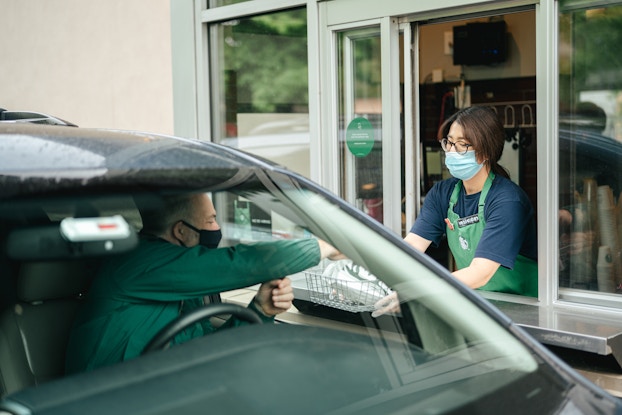
The pandemic has created an opportunity for Starbucks to accelerate social-distance-minded changes to its store base and enhance its digital and mobile sales capabilities, the company’s president and CEO said in a recent webinar presented by the National Retail Federation.
“There is a significant amount of real estate that is becoming available as a result of this pandemic,” said Kevin Johnson, who has has been at the helm of the multinational coffee chain since 2017. “We believe that rent rates are going to be lower than they were before, because there will be a lot of available real estate, so we are going to take this opportunity to transform the store portfolio.”
The Seattle-based company, with more than 15,000 cafés in the U.S., is exploring opportunities to open more grab-and-go locations without seating — a walk-up version of the drive-thru concept that has served the company well, Johnson said. These walk-up stores, dubbed, “Starbucks Pickup,” would be designed to complement Starbucks’ traditional store base, particularly in dense metropolitan areas, he said in the webinar.
In addition to exploring new store format opportunities, Starbucks is also enhancing its remote ordering capabilities through its popular mobile app. The retailer is readying a new mobile feature that will enable customers to order its gift merchandise via its app, rolling it out in time for the holiday selling season.
The moves come as the retailer battles the blows of COVID-19. This week, Starbucks reported its steepest earnings- per-share loss in more than a decade, as sales plunged amid the pandemic.
I think the concept of offering experiences that are safe, familiar and convenient is going to be the theme until there’s a vaccine.
Kevin Johnson, president and CEO, Starbucks
Pivot
Expanding mobile ordering and adding merchandise for purchase on its app are two ways Starbucks is strategizing its reopening. Read on for more reopening ideas that businesses are embracing.
Driving (no-touch) sales via mobile orders
With its vast database of app users, Starbucks has the opportunity to market retail products to its customers directly, Johnson explained. Ordering through the app also provides a safe and convenient option for shoppers seeking gifts — something that will be vital to the success of all retailers throughout the rest of the year and into next year, Johnson said.
“I think the concept of offering experiences that are safe, familiar and convenient is going to be the theme until there’s a vaccine,” he said.
Making merchandise available for sale through the app also makes sense from a consumer trend standpoint, as at-home coffee consumption has increased significantly during the pandemic. A survey conducted by payment technology provider Square and the Specialty Coffee Association found that sales of coffee equipment such as grinders, presses and kettles increased 11% in the first few months of the pandemic, while food retailers report ongoing strong sales of coffee grounds and whole beans for home consumption.

Tapping lessons from Starbucks China to create safe experiences
Retailers and restaurants will need to think about how they provide a great customer experience while at the same time satisfying consumer demands for safety, familiarity and convenience, he said.
“If [consumers] are going to go somewhere and have an experience, they want to go somewhere that is safe and that is not going to lead to them either getting COVID or being exposed to COVID,” Johnson said.
Starbucks’ large presence in China, where the coronavirus first began to spread, helped the company prepare for how it would respond to the virus around the world. In partnership with the company’s leadership in China, Starbucks established three basic principles that became the framework for how it would execute its response in every market:
- Prioritize the safety, health and well-being of Starbucks workers and customers.
- Support government and local health officials as they work to mitigate and contain the virus.
- “Show up” in a positive and constructive way, and be responsible in every community where it operates.
Johnson said once this basic framework was established, the company relied on the concept of “distributed leadership” — which he described as trusting store-level managers to make decisions based on the conditions in their individual markets, using the tools and information supplied to them by upper management.
“I believe in every store manager [who] runs their store,” said Johnson. “They are going to, with good intention, do what they believe is the right thing.”

CEO: Open communication is key amid health crisis, racial injustice
Having platforms for open communication throughout the organization has been important to the company’s management strategy during the crisis, Johnson explained. For example, after Starbucks’ top corporate managers decided to require customers to wear masks inside all of its locations, a meeting among store managers revealed that some had questions about the issue.
Conversations with store managers helped the company resolve some of the real-world issues that stores were encountering in enforcing the wearing of masks.
“We might think we have answered all the questions, but still there were things they were struggling with,” said Johnson, although he did not elaborate what specific challenges employees were facing.
It has been important, he said, to have “transparent, two-way dialogue” that allows managers to be comfortable asking questions, asking for help if needed and sharing best practices.
Those same principles have also helped the company navigate the environment of racial unrest that has followed the recent murders of Ahmaud Arbery, George Floyd and others. Johnson said Starbucks had already undertaken a serious, introspective look at the issue of racial discrimination after a 2018 incident in a Philadelphia Starbucks in which two Black customers were arrested as they conducted a business meeting in a Starbucks café.
Since that time, Starbucks held companywide meetings in which employees of color were encouraged to talk abut their experiences with prejudice.
“We have been on a journey to raise awareness [of] the bias that each of us has, from our own life experiences and journeys,” Johnson said, “and how we [can] work together to create a more inclusive environment,” he said. “We believe at Starbucks [that] we have a responsibility to stand up and play a positive, constructive role in addressing this, and that’s exactly what we are doing.”
Matthew Shay, president and CEO of NRF, agreed that business leaders needed to take an empathetic approach to the issue.
“It begins with listening with a truly different set of ears and a different level of openness than we have ever had before,” Shay said during the webinar.
CO—is committed to helping you start, run and grow your small business. Learn more about the benefits of small business membership in the U.S. Chamber of Commerce, here.








